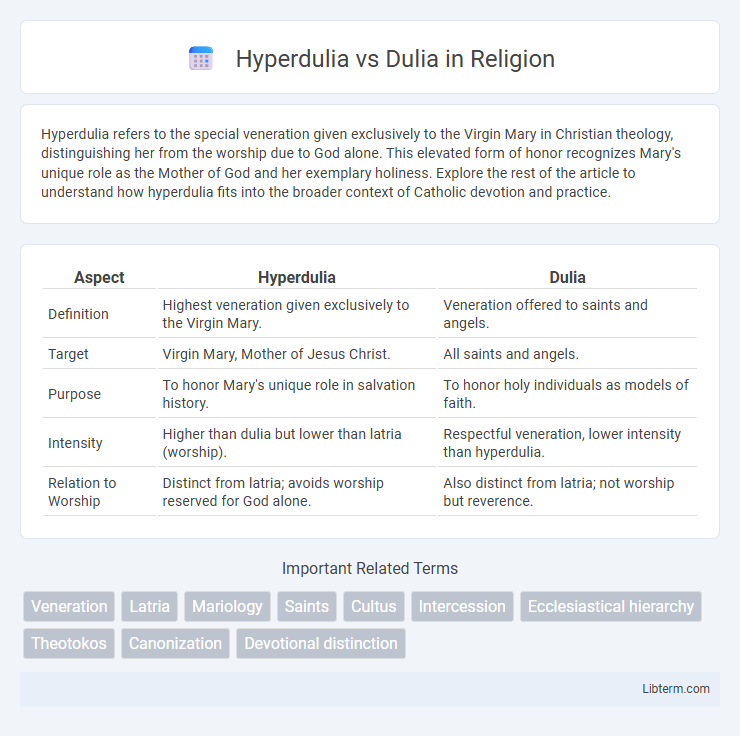Hyperdulia refers to the special veneration given exclusively to the Virgin Mary in Christian theology, distinguishing her from the worship due to God alone. This elevated form of honor recognizes Mary's unique role as the Mother of God and her exemplary holiness. Explore the rest of the article to understand how hyperdulia fits into the broader context of Catholic devotion and practice.
Table of Comparison
| Aspect | Hyperdulia | Dulia |
|---|---|---|
| Definition | Highest veneration given exclusively to the Virgin Mary. | Veneration offered to saints and angels. |
| Target | Virgin Mary, Mother of Jesus Christ. | All saints and angels. |
| Purpose | To honor Mary's unique role in salvation history. | To honor holy individuals as models of faith. |
| Intensity | Higher than dulia but lower than latria (worship). | Respectful veneration, lower intensity than hyperdulia. |
| Relation to Worship | Distinct from latria; avoids worship reserved for God alone. | Also distinct from latria; not worship but reverence. |
Introduction to Hyperdulia and Dulia
Hyperdulia and dulia are terms describing levels of veneration within Christian theology, particularly in Catholic practice. Hyperdulia is a special veneration reserved exclusively for the Virgin Mary, acknowledging her unique role and holiness above all other saints. Dulia refers to the honor given to saints and angels, distinct from latria, which is worship due to God alone, establishing a clear hierarchy of reverence.
Defining Hyperdulia: Meaning and Origin
Hyperdulia is a term in Catholic theology denoting an elevated form of veneration specifically reserved for the Virgin Mary, surpassing the general honor given to saints through dulia. Originating from the Greek words "hyper," meaning "above," and "doulia," meaning "service" or "veneration," it distinguishes the unique reverence owed to Mary due to her role as the Mother of God. This hierarchical classification clarifies theological practices by emphasizing different levels of honor: latria for God, hyperdulia for Mary, and dulia for other saints.
Understanding Dulia: Scope and Significance
Dulia represents the veneration given to saints and angels, acknowledging their holiness and intercessory role without equating it to worship reserved for God alone. This form of reverence highlights respect and honor, distinct from latria, which is adoration directed solely to the Divine. Understanding dulia is crucial for appreciating the theological distinctions in Christian devotional practices, emphasizing the hierarchy of reverence within Catholic and Orthodox traditions.
Theological Foundations of Hyperdulia
Hyperdulia represents a distinct level of veneration reserved exclusively for the Virgin Mary, reflecting her unique role in salvation history, whereas dulia pertains to the honor given to saints as exemplary followers of Christ. The theological foundations of hyperdulia emphasize Mary's singular grace, divine motherhood, and Immaculate Conception, which elevate her above all other creatures yet below the worship due to God alone. This nuanced hierarchy of veneration maintains the distinction between worship (latria) directed solely to God and the reverence accorded to Mary and the saints within Catholic doctrine.
Saints and the Practice of Dulia
Hyperdulia represents the highest form of veneration given specifically to the Virgin Mary, surpassing the general respect accorded to all saints through dulia. Dulia is the reverent honor directed toward saints as holy individuals who intercede for believers, distinct from latria, which is reserved for worship of God alone. The practice of dulia emphasizes recognizing the saints' exemplary lives and their role as spiritual mediators, fostering devotion without implying divine status.
The Unique Role of the Virgin Mary in Hyperdulia
Hyperdulia represents a distinct level of veneration reserved exclusively for the Virgin Mary, highlighting her unparalleled role in salvation history, which surpasses the general honor given in dulia to all saints. This special form of reverence emphasizes Mary's unique grace, immaculate nature, and intercessory power, setting her apart from other revered figures. Catholics distinguish hyperdulia from dulia to honor Mary's singular status without equating her to the divine worship due to God alone (latria).
Hyperdulia vs Dulia: Key Differences
Hyperdulia differs from dulia primarily in the degree of honor given; hyperdulia represents the highest veneration afforded exclusively to the Virgin Mary, while dulia refers to the respectful honor given to saints and angels. Hyperdulia acknowledges Mary's unique role in salvation history, emphasizing her exalted status without equating her to divine worship known as latria. This hierarchical distinction clarifies theological practices in Catholic devotion, ensuring proper reverence is maintained according to doctrinal significance.
Liturgical Expressions of Hyperdulia and Dulia
Hyperdulia in liturgical expressions is reserved exclusively for the veneration of the Virgin Mary, distinguishing her honor from the general saints who receive dulia. Liturgical prayers and hymns dedicated to Mary often include titles and praises highlighting her unique role and higher dignity, such as "Queen of Heaven," emphasizing the elevated reverence that surpasses dulia. In contrast, dulia in liturgy manifests through prayers and rituals honoring saints as intercessors without attributing them divine status, maintaining a clear theological distinction within worship practices.
Common Misconceptions and Clarifications
Hyperdulia is a specific veneration accorded exclusively to the Virgin Mary, distinct from dulia, which is the respect given to all other saints. A common misconception is that hyperdulia equates Mary's honor to worship, but it remains a form of veneration far below the worship reserved solely for God, called latria. Clarifying this distinction helps prevent confusion between worship and honor in Catholic theology, ensuring the proper understanding of Mary's unique role compared to other saints.
The Importance of Proper Veneration in Catholic Tradition
Hyperdulia represents the highest form of veneration accorded exclusively to the Virgin Mary in Catholic tradition, distinct from dulia, which is the reverence given to all other saints. Proper veneration emphasizes honoring Mary's unique role as the Mother of God without equating it to worship due only to God, maintaining clear theological boundaries. This distinction is crucial in Catholic doctrine to preserve the integrity of worship (latria) directed solely to the Holy Trinity.
Hyperdulia Infographic

 libterm.com
libterm.com